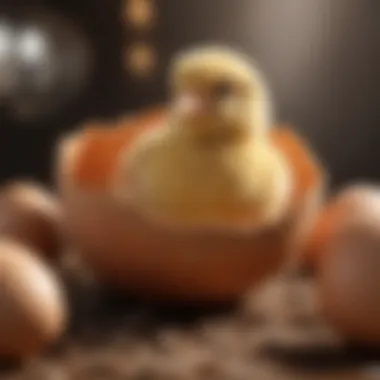Understanding the Hatching Process of Chicken Eggs


Intro
Hatching chicken eggs is a fascinating process, blending biology with agriculture. Understanding this process is essential for anyone interested in poultry farming, whether a novice or an experienced breeder. The journey from a fertilized egg to a fully formed chick involves a series of carefully timed stages, each requiring specific conditions for success.
In this article, we will explore the various aspects of egg hatching. We shall delve into the environmental requirements, the physiological changes of the embryo, and practical tips to overcome common challenges. This comprehensive overview aims to equip poultry enthusiasts with vital knowledge to optimize their hatching efforts.
Essential Conditions for Incubation
Creating the right environment is crucial for successful hatching. Factors such as temperature, humidity, and air circulation must be carefully controlled. Here are the key conditions:
- Temperature: The ideal temperature for incubation ranges from 99 to 102 degrees Fahrenheit. A consistent temperature is necessary to ensure the embryo develops correctly.
- Humidity: Maintaining 50-55% humidity during incubation helps prevent the eggs from drying out. During the last few days before hatching, raising humidity to 65% is essential.
- Ventilation: Proper airflow is important. Fresh air supplies oxygen to the developing embryo while removing carbon dioxide.
Stages of Embryonic Development
Embryonic development occurs in a series of stages:
- Ovulation and Fertilization: The hen lays fertilized eggs, which can be stored for a limited time.
- Cell Division and Development: After incubation begins, the embryo divides and grows. This marks the start of significant development.
- Formation of Organs and Features: Major organs and features develop within the first few days. This includes the heart, which begins to beat around the third day.
- Feather and Bill Development: As the hatch date approaches, feathers develop, and the beak begins to harden. This stage is critical for the chick's ability to break out of the eggshell.
- Hatching: This final stage typically occurs on the 21st day. The chick uses its beak to break through the shell.
Common Challenges in Hatching
Hatching chicken eggs is not without its challenges. Here are some common issues faced:
- Temperature Fluctuations: Changes can disrupt the development process, potentially leading to failure.
- Excess Moisture: Too much humidity can cause a chick to drown or lead to a malformed beak.
- Ventilation Problems: Poor air circulation can suffocate embryos.
By being aware of these challenges, one can take preventative measures. Proper monitoring and adjustments can improve hatching success.
Success in hatching chicken eggs requires patience, precision, and attention to detail.
Practical Tips for Successful Hatching
To maximize your hatching success, consider the following tips:
- Use a reliable incubator that allows you to control temperature and humidity.
- Regularly check on the eggs to monitor their development.
- Mark fertile and non-fertile eggs to avoid confusion.
- Research breed-specific needs, as some breeds may have additional requirements.
Culmination
The process of hatching chicken eggs is intricate and requires careful attention to detail. By understanding the necessary conditions, stages of development, and how to mitigate common challenges, poultry enthusiasts can enhance their hatching techniques. This knowledge not only nurtures the success of hatching but also enriches the overall experience in poultry farming.
Understanding the Basics of Chicken Eggs
Understanding chicken eggs is fundamental to mastering the art of incubation and hatching. This section discusses essential elements such as the anatomy and types of chicken eggs, paving the way for a deep comprehension of what it takes to nurture life from within an egg. For poultry enthusiasts, both beginners and experienced ones, of knowledge about the basics of chicken eggs greatly increases the chance of a successful hatching process.
Anatomy of a Chicken Egg
A chicken egg consists of several parts, each serving a crucial function in protecting and nourishing the developing embryo. The egg's main components include:
- Shell: The outermost layer, composed mainly of calcium carbonate, providing both protection and structure.
- Egg White (Albumen): Clear and viscous, the egg white surrounds the yolk and provides water and protein to the embryo.
- Yolk: The yellow part that contains fats, vitamins, and minerals essential for the growth of the embryo.
- Chalazae: These white strands anchor the yolk in place within the egg white, ensuring it remains centered.
- Membranes: The inner and outer membranes provide additional layers of protection against bacterial invasion.
Each of these parts plays a vital role in the survival of the embryo until it is ready to hatch. Understanding this anatomy helps in assessing the quality of eggs and determining their readiness for incubation.
Types of Chicken Eggs


Chicken eggs come in a variety of types, and understanding these distinctions is significant for hatching success. Here are some common types:
- Fertile Eggs: These eggs have been fertilized by a rooster and have the potential to develop into chicks if properly incubated.
- Infertile Eggs: These are produced without fertilization and will not develop into embryos. While they can still be incubated, they will not hatch.
- Organic Eggs: These are produced by chickens that are raised according to organic farming methods. These eggs can be both fertile and infertile.
- Free-Range Eggs: Chickens that produce these eggs are allowed to roam freely outside, which can lead to healthier birds and potentially higher quality eggs.
Choosing the right type of egg for incubation is key to achieving the desired results in the hatching process. Each type has its own set of characteristics that can impact development, health, and the overall outcome.
Understanding the basics of chicken eggs is a critical first step towards successful hatching and nurturing of young chicks. Knowing their anatomy and type enables better preparation and management during incubation.
The Science of Incubation
The process of incubating chicken eggs is a critical phase in poultry development. Understanding the science behind incubation allows poultry enthusiasts to foster a suitable environment for the embryos. Successful incubation hinges on creating optimal conditions that promote development and eventual hatching. Temperature and humidity are the two most crucial environmental factors that directly affect embryo viability. Proper assessment of these elements leads to higher success rates in hatching.
The Role of Temperature and Humidity
Temperature and humidity play pivotal roles in the incubation process. Each has its unique significance, shaping the embryo's growth.
Optimal Temperature Ranges
Optimal temperature ranges are essential for successful hatching. Typically, the ideal incubation temperature ranges from 99.5°F to 101°F (37.5°C to 38.3°C). Within this range, embryos develop efficiently and consistently.
The key characteristic of maintaining optimal temperature is its direct impact on metabolic processes. This includes crucial aspects like growth rates and embryo development. This temperature range is a popular choice among poultry breeders due to its reliability. It ensures stable conditions for the embryos, reducing the risk of deformities and developmental issues.
Unique features of optimal temperature include impacts on heart rate and tissue development. However, any deviation from this range can lead to drastic consequences. An increase in temperature could lead to overheating and embryo mortality. Conversely, too low a temperature can slow metabolism and result in failure to hatch.
Humidity Control Techniques
Humidity control techniques are equally important in the incubation process. Maintaining adequate humidity levels, generally between 40% to 60% during incubation and around 65% for hatching, is necessary for successful embryo development.
The key characteristic of humidity includes moisture exchange through the egg. This moisture plays a vital role in allowing the developing embryo to breathe and absorb necessary nutrients. Because of its significance, maintaining humidity is a beneficial practice in poultry incubation.
Unique features of humidity control involve techniques such as using wet sponges or water trays in incubators. These methods can directly adjust humidity levels. The advantages of proper humidity control include preventing excessive drying of the egg membranes, which would lead to poorly developed chicks. However, excess humidity can also be harmful, causing issues such as weak chicks and high embryo mortality.
Incubation Period: What to Expect
The incubation period for chicken eggs typically lasts about 21 days. During this time, eggs undergo various stages of development. Each stage brings distinct changes within the egg, resulting from preceding factors such as temperature and humidity. Recognizing these stages helps breeders monitor the health of both the eggs and the developing chicks closely.
Preparing for Hatching
Preparing for hatching is a pivotal phase in the journey of raising chickens. This section focuses on essential elements and their significance in ensuring a successful hatch. It involves not only selecting the right tools and equipment but also understanding the conditions necessary for the embryos to develop into healthy chicks. A well-prepared environment lays the groundwork for optimal incubation.
Choosing the Right Incubator
The choice of incubator is crucial. An incubator serves as the controlled environment that mimics a hen sitting on her eggs. There are various types of incubators available in the market, including forced-air and still-air models. Each has its own pros and cons.
- Forced-Air Incubators: These models use a fan to circulate air, ensuring even temperature and humidity throughout. This can lead to more consistent hatching rates.
- Still-Air Incubators: These lack a fan and rely on natural convection for air circulation. They are often less expensive but can lead to temperature variations, which may affect hatching success.
When selecting an incubator, consider the following factors:
- Size: Ensure it can hold the number of eggs you plan to incubate.
- Temperature Control: A reliable thermostat is vital for maintaining constant temperature.
- Ease of Use: Look for features like automatic egg turners and humidity monitoring.
Taking the time to choose the right incubator can significantly enhance your hatching experience.
Handling and Storing Eggs


Proper handling and storage of eggs before incubation directly influence their viability. Preferably, eggs should be collected several times a day to minimize the risk of damage and contamination. Here are key guidelines for handling and storing eggs:
- Cleaning: Only clean eggs if there is visible dirt. Use a dry cloth to gently remove debris. Avoid washing eggs with water, as it can remove the protective bloom.
- Storage Position: Store eggs with the pointed end down. This positioning helps keep the yolk centered.
- Temperature: Aim to store eggs at a temperature between 50°F and 60°F (10°C to 15°C). Avoid temperatures higher than this, as they can reduce hatch rates.
- Humidity: Keep humidity levels low to prevent moisture loss. A relative humidity of around 75% is advisable in storage.
Eggs should not be stored for more than two weeks prior to incubation, as the viability decreases over time. Proper care in this initial stage enhances the chances for a high hatch rate once the incubation begins.
Embryonic Development Stages
The embryonic development stages are a crucial element in understanding the hatching process of chicken eggs. Each stage presents specific developments that reveal the health and viability of the embryo. Mastering this knowledge benefits both novice and seasoned poultry enthusiasts. Not only does it enhance their practical skills, but it also fosters a deeper appreciation for the complexity of life.
Day-by-Day Breakdown of Development
From the moment an egg is fertilized, it begins a remarkable journey of development. This process can be carefully tracked on a day-by-day basis, rendering a clearer understanding of what to expect.
- Day 1: Fertilization occurs. The embryo is formed, starting as a single cell that rapidly divides.
- Day 2-3: Major organs and systems start to form. The heart begins beating by the end of Day 3.
- Day 4-5: Limb buds begin developing. Feathers start to appear within the skin.
- Day 6-7: The beak and eyes form. The embryo is well-structured at this stage, showing significant growth.
- Day 8-10: The embryo continues to grow and differentiate. Initial feather patterns become more noticeable.
- Day 11-14: Rapid growth phase. The beak and claws are developing.
- Day 15-18: Major body parts are fully formed. The chick occupies a significant portion of the eggshell’s interior.
- Day 19: Internal structures are mature. The chick begins preparing for hatch by repositioning itself, usually facing downward.
- Day 20-21: Hatching occurs. The chick breaks through the shell and emerges.
This day-by-day breakdown allows those involved in hatching to monitor the developmental progress, ensuring that the incubating conditions are optimal.
Signs of Successful Development
Monitoring signs of successful development is integral in determining whether embryos are progressing as expected. Observing these indicators can help identify any potential issues early in the process. Key signs include:
- Movement: As the chick develops, movement within the egg can be observed, particularly in the later stages.
- Air Cell Development: The air cell forms at the broad end of the egg, and its size can be an indicator of the chick’s growth.
- Weight Change: Eggs should lose a certain percentage of weight by the end of the incubation period, suggesting that moisture loss is occurring as needed.
- Temperature Regulation: The embryo maintains its own temperature regulation, and abnormal temperature readings may indicate issues.
Successfully detecting these signs early helps prevent complications during the latter stages of incubation. With careful observation, the poultry enthusiast can enhance hatching success rates, making the endeavor more rewarding.
“Understanding embryonic development not only aids in successful hatching but also enriches our connection with the life we nurture.”
Common Challenges in the Hatching Process
Hatching chicken eggs is a complex procedure that can encounter several hurdles. Understanding these challenges is crucial for anyone interested in poultry farming. This section explores common issues that can arise during the hatching process, focusing on fertility problems and the outcomes of failed hatchlings. By addressing these pitfalls, poultry enthusiasts can enhance their success rates and ensure healthier chicks.
Identifying Fertility Issues
Fertility issues can significantly impact the hatching process. If eggs are not fertilized, or if there are problems in the development stages, the chances of a successful hatch diminish. Here are key points to consider when examining fertility:
- Inspect the Breeders: Ensure that the parent chickens are healthy, with no signs of disease. Physical fitness can influence egg fertility.
- Determine Mating Ratios: An optimal breeding ratio of roosters to hens is vital. A common recommendation is one rooster for every ten hens.
- Monitor Egg Collection Practices: Eggs should be collected frequently and handled with care. Cleanliness is paramount to avoid contamination.
Fertility testing can also be employed. Candling eggs around day seven helps to identify embryos and assess viability. By eliminating non-fertile eggs early, one can increase the chances of hatching success as effort can be focused on viable eggs. Moreover, knowing the fertility rate can inform breeding decisions.
Dealing with Failed Hatchlings
Occasionally, even with optimal conditions, some hatchlings do not make it. Understanding the reasons behind this can help mitigate future losses. Here are some strategies for dealing with failed hatchlings:
- Evaluate Incubator Settings: Incorrect temperature or humidity levels may contribute to unsuccessful hatching. Regularly check and calibrate equipment.
- Assess Egg Quality: Before incubation, ensure eggs are clean, uncracked, and of suitable age. Older eggs often have lower hatch rates.
- Monitor Development: Candling eggs throughout incubation can offer insights into embryo health. Signs of deterioration should be addressed immediately.
It is also important to document hatch rates and outcomes. This practice helps identify patterns over time. Notable observations can lead to improved methods and ultimately higher success rates.
Successful hatching is about proactive management and understanding all factors involved.
Post-Hatching Care
Post-hatching care is critical for the successful transition of newly hatched chicks. Once the chicks emerge, the environment and attention they receive can significantly influence their health and future growth. A strong start in life paves the way for robust chickens and optimal egg production later on.


Immediate Needs of Chicks
Upon hatching, chicks have several urgent needs that must be met to ensure their survival.
- Heat Source: Chicks are not capable of regulating their body temperature immediately after birth. They require a source of gentle heat to maintain warmth. A heat lamp or brooder is ideal for this purpose, set at around 95°F (35°C). Gradually, the temperature can be lowered by 5°F (2°C) each week.
- Clean Environment: A clean, dry space is crucial for preventing diseases. The brooder should be lined with fresh bedding material, such as pine shavings or straw. Regular cleaning should be done to remove waste and soiled bedding.
- Water Access: Fresh and clean water must be provided at all times. Newly-hatched chicks often struggle to find water. Therefore, it might be necessary to dip their beaks into the water dish to encourage drinking.
- Nutrition: Nutritional needs should also be prioritized. It is advisable to feed them a starter feed formulated for chicks. This feed contains the right balance of vitamins and minerals to support growth.
Chicks are most vulnerable during their first few days, making it essential to monitor them closely.
Long-Term Health Considerations
Ensuring long-term health for chicks involves ongoing care and monitoring, which includes several vital practices.
- Ongoing Nutrition: As chicks grow, their dietary needs will change. Transitioning them to appropriate grower feeds will help them develop strength and healthy plumage. It's important to ensure that their diet contains adequate protein, which is essential for muscle and feather development.
- Health Monitoring: Regularly observing the chicks for signs of illness is essential. Symptoms can include lethargy, odd postures, and abnormal droppings. Early identification allows for timely intervention.
- Vaccination and Biosecurity: Vaccinating against common diseases that affect poultry can safeguard long-term health. Establishing a biosecurity protocol to prevent disease spread is also crucial. This involves limiting contact with other birds and maintaining cleanliness in the environment.
- Socialization: Chicks are social animals. They thrive in a setting where they can interact with each other. Adequate space must be provided to minimize stress and facilitate natural behaviors, including pecking and scratching.
In summary, effective post-hatching care combines immediate response to the chicks' critical needs while planning for their ongoing health. This balanced approach ultimately supports their development into healthy, productive birds.
Ethical Considerations in Hatching Practices
When engaging in the process of hatching chicken eggs, it is crucial to reflect on the ethical implications interwoven within this practice. The welfare of the animals involved is paramount. Poultry enthusiasts and farmers must ensure that their methods prioritize the health and well-being of chickens, both before and during the hatching process. Ethical considerations serve not just as moral guidelines but also as practical strategies that can yield benefits, such as improved productivity and a happier flock.
Responsible Breeding Practices
Responsible breeding practices involve making informed decisions regarding the selection of parent birds. The goal is to promote genetic health and avoid inbreeding. Selecting healthy, robust chickens contributes to better hatch rates and overall chick vitality.
Key aspects include:
- Health Checks: Regular veterinary assessments ensure that the breeding stock is free from diseases.
- Genetic Selection: Choose birds that display desirable traits, such as temperament and resilience. This enhances not just their wellbeing but the overall quality of future generations.
- Limitations on Breeding Frequency: Overbreeding can lead to physical stress and health issues. Setting reasonable limits facilitates healthier breeding cycles.
Understanding that the consequences of breeding practices extend beyond personal benefits to the welfare of the entire flock underscores the importance of being mindful in this area.
Understanding Genetic Diversity
Genetic diversity is vital for the long-term sustainability of poultry populations. High levels of genetic variation within a flock can increase resilience against diseases and environmental stressors. Lack of diversity, on the other hand, can lead to vulnerabilities.
Practices to enhance genetic diversity include:
- Introducing New Breeds: Bringing in new bloodlines prevents stagnation and promotes resilience.
- Avoiding Close Relatives: Minimize mating within the same family to prevent genetic disorders and weaknesses.
- Documenting Lineage: Keeping records helps track genetic backgrounds and ensures diverse breeding choices.
Maintaining genetic diversity is not just a practice; it is a necessity that enhances the life quality of future generations.
Resources for Further Learning
Understanding the hatching process goes beyond the immediate tasks of incubation and care. Educating oneself through various resources enhances not just knowledge, but also improves practices in poultry breeding and management. By tapping into reputable learning materials, both novice and experienced chicken keepers can equip themselves with insights that ensure a successful hatching process.
Books and Online Courses
Books offer a wealth of detailed information and can be an invaluable resource for anyone interested in the hatching of chicken eggs. Titles like Storey's Guide to Raising Chickens provide in-depth instructions on every aspect of chicken care, including hatching techniques.
Online courses are also a great way to learn. Websites such as Coursera and Udemy feature courses focused on poultry farming. These courses often combine theoretical knowledge with practical exercises, allowing learners to apply what they learn in a controlled setting. The structure is often flexible, making it easier to fit into busy schedules. Moreover, many courses are taught by experts in the field who share their own experiences.
Communities and Forums
Joining communities and forums can provide direct support and shared knowledge from other poultry enthusiasts. Websites like Reddit have active forums where chicken keepers discuss their experiences, share tips, and troubleshoot problems related to hatching. These platforms allow members to ask questions and get varied perspectives from individuals with diverse backgrounds.
Facebook groups dedicated to poultry care can also be beneficial. Members often post updates about their own hatching experiences, ask for advice, and share resources. Engaging in conversations within these forums fosters a sense of community and helps individuals stay motivated in their poultry endeavors.
Important Note: Engaging with others in the field can offer valuable insights that books or courses may not cover.
In essence, seeking out resources such as books, online courses, and active community forums can significantly enrich one's understanding of hatching chicken eggs. They provide a structured way to obtain information while also offering practical advice grounded in real-world experiences.







